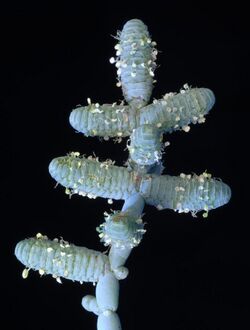Biology:Tecticornia verrucosa
| Tecticornia verrucosa | |
|---|---|

| |
| Scientific classification | |
| Kingdom: | Plantae |
| Clade: | Tracheophytes |
| Clade: | Angiosperms |
| Clade: | Eudicots |
| Order: | Caryophyllales |
| Family: | Amaranthaceae |
| Genus: | Tecticornia |
| Species: | T. verrucosa
|
| Binomial name | |
| Tecticornia verrucosa Paul G.Wilson
| |

| |
| Occurrence data from AVH | |
Tecticornia verrrucosa is a species of plant that is succulent and halophyte (salt tolerant). This plant was a member of the Chenopodiaceae,[1] which are now included in family Amaranthaceae.
T. verrucosa was first described in 1972 by Paul Wilson.[2]
It is an annual or short-lived perennial which grows to 40 cm high, which branches at the occasionally woody base. The inflorescence is a set of opposite and decussate lateral sessile spikes, at right angles to the branch. They are cylindrical and 10–20 mm long by 6 mm diam. The flowers are triads with free tepals below and slightly united above.[3]
It grows on coastal mud flats, slightly saline clay pans, and inland freshwater.[3]
The Walmajarri people of the southern Kimberley call this plant Mungily.[4]
References
- ↑ Cite error: Invalid
<ref>tag; no text was provided for refs namedapni - ↑ , pp. 284, 286, Figs 1 A-C, 3, Wikidata Q100729854
- ↑ 3.0 3.1 Paul G.Wilson (2020). "Tecticornia verrucosa". Flora of Australia (Canberra: Australian Biological Resources Study, Department of Agriculture, Water and the Environment). https://profiles.ala.org.au/opus/foa/profile/Tecticornia%20verrucosa. Retrieved 6 November 2021.
- ↑ , pp. 87, Wikidata Q106088428
Wikidata ☰ Q25846850 entry

